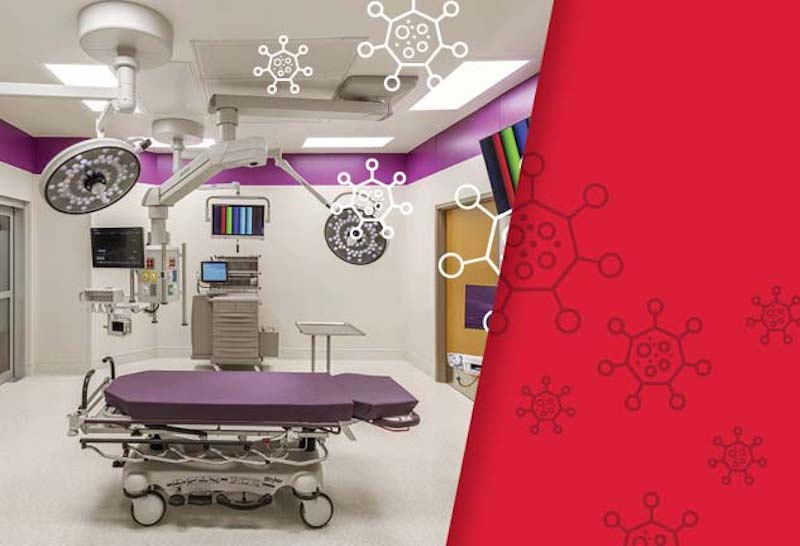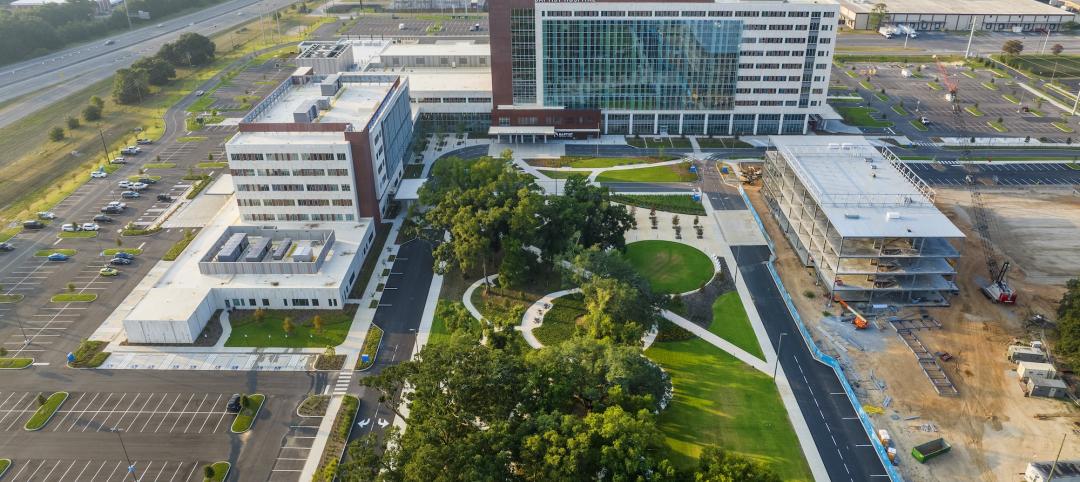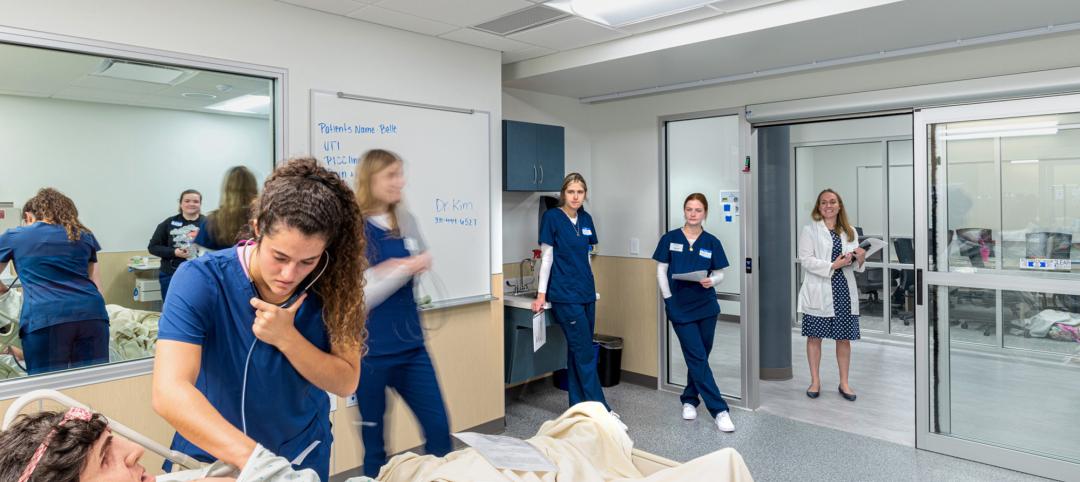The COVID-19 pandemic has strained the resources and exposed the vulnerabilities of many hospitals as they confront the most serious global health crisis in over a century. Controlling the spread of this highly contagious virus while treating infected patients and protecting staff is fundamental to the mission of every healthcare facility.
Yet infection control remains one of the most challenging aspects of hospital operations.
Each year, healthcare-associated infections impact 1.7 million patients at U.S. acute care facilities, resulting in tens of thousands of deaths and costing the healthcare system billions of dollars.1
As hospitals and health systems assess their existing infrastructure and plan for the future, they can learn valuable lessons from the infection control strategies implemented at high-containment research labs. These secure research environments are designed and built with the primary function of protecting individuals and communities from microorganisms, infectious agents and other toxins.
McCarthy recently conducted a study of healthcare providers, architects and engineers to learn about their response to COVID-19. We discovered that as many healthcare providers consider implementing enhanced infection control strategies, they are also assessing the construction implications for existing and new facilities. They know it is not practical — nor economically feasible — to implement all the intricate safety and security strategies of a high-containment lab. As a result, they are consulting proven BSL-4 builders for valuable guidance on the design and construction of future healthcare environments.
Having built more than 25 percent of the nation’s BSL-4 labs in the last 20 years while earning a consistent ranking as one of America’s top healthcare builders, McCarthy is helping clients identify effective and value-driven infection control solutions for their facilities.
Here are five core principles from high-containment labs that directly support the current infection control priorities of hospitals and other healthcare facilities:
1. Design and build flexible infrastructure for responding to future crises.
Hospitals of the future will be expected to quickly adapt to accommodate patient surges resulting from unforeseen events such as a pandemic or natural disaster. Public spaces may need to be converted into triage or patient care spaces during an emergency. For example, at the new Stanford Hospital in Palo Alto, Calif., the attached parking garage and interior public spaces were designed and built with the capability of transforming into triage spaces if necessary.
Similarly, primary patient care spaces such as an ICU or surgical area may need to temporarily function as a negative pressure isolation room to contain airborne contaminants. Only 2 to 4 percent of all U.S. hospital rooms are currently equipped for negative pressure, as these spaces must be airtight and have a dedicated exhaust system and HEPA filters.3
A skilled builder can help you overcome the numerous design and construction challenges of creating these isolation spaces and the associated maintenance considerations. This includes the need to certify HEPA filters annually and replace them frequently to prevent buildup of dirt and contaminants.
2. Separate and safely manage waste streams.
U.S. hospitals produce more than 5 million tons of medical waste each year.4 About 15 percent of this waste is considered hazardous and must be handled and disposed of according to strict local laws and guidelines. In a BSL-4 lab, all waste — including filtered air, water, effluent and trash — must be decontaminated before it can leave the facility.
By using the knowledge gained constructing BSL-4 facilities, the right partner can work with you to develop new infectious waste management practices separate from the existing hospital waste management system. This includes the establishment of a dedicated process to collect, capture, decontaminate and dispose of and/or incinerate all solid and liquid waste. It may also involve installation of an effluent decontamination system to neutralize all liquid waste materials before they are released into the environment.
3. Develop new strategies and protocols to protect healthcare workers.
In both lab and hospital environments, the greatest potential risk is not the building, mechanical systems or equipment. It is the people who inhabit the space. Anytime the human element is involved, it increases the risk of noncompliance with operational policies, procedures and protocols. And once there’s a breach in protocol, the probability of cross-contamination rises exponentially.
While it’s impossible to eliminate all potential risks for hospital workers, BSL-4 builders know creating spaces and systems that reduce the likelihood of cross-contamination is possible. These strategies include establishing secure, restricted areas for gowning and accessing other PPE, investing in touchless sinks and lighting, and installing self-closing, lockable doors.

McCarthy is currently working with the Flad / Page partnership to design and construct the CDC’s new High Containment Continuity Laboratory in Atlanta. The building will be a Biosafety Level-4 (BSL-4) facility, a designation reserved for the highest level of biological safety, and it will accommodate approximately 80 laboratory researchers.
High-containment labs are also designed to accommodate employee movement and flow strategies. For example, many labs are designed with a two-person rule in mind; each researcher has a colleague present to assist if something goes wrong. High-containment areas also have built-in sightlines to maintain visual connectivity from outside. These same design principles can be implemented in new or existing hospitals to enhance infection control and reduce risk for staff and patients.
4. Rethink patient flows to stop disease at the door.
From check-in to follow-up, the entire healthcare experience must become more automated and efficient. Some hospitals are experimenting with telemedicine, remote triaging and a zero-contact intake process using robotics and geolocation to ensure admissions are made with as little contact with staff and other patients as possible.5
Others are considering the elimination of traditional emergency room waiting areas and designating separate entrances and waiting spaces for suspected infectious or high-risk patients. For example, McCarthy is researching alternatives like RFID (Radio-Frequency Identification) technology for tracking people and materials as they enter and move throughout BSL-4 facilities. In hospitals, the same technology could track and alert patients and their families as they’re waiting, and as part of a comprehensive wayfinding system would be capable of efficiently directing them to the right location for treatment.
5. Reassure patients and visitors they’re in a safe environment.
In recent years, the healthcare industry has focused on hospitality and patient-centered design, which has resulted in many beautiful, state-of-the-art facilities. As hospitals consider how to adapt their buildings and spaces to address current realities and future code changes, they need to consider the optics of those decisions. Will patients and visitors notice the alterations, and if so, will the strategies instill confidence and peace of mind that they are in a secure, protected environment? This extends to everything from signage to physical barriers to visible ventilation systems. In the future, designers, builders and owners will need to expand their definition of patient-centered to ensure people using the system feel safe.
Using BSL-4 construction principles to modify how future healthcare facilities are designed, built, operated and maintained can help control the spread of infectious disease and reduce the negative impact of future outbreaks. At the same time, these changes can enhance the overall perceptions and experiences of patients, staff and visitors even when there is no crisis.
Building for the Future
The COVID-19 pandemic has quickly transformed how healthcare providers must assess and address infection control within their facilities. Once a secondary consideration, infection control is now a top safety priority shaping the future of every healthcare facility in America.
The good news is builders like McCarthy — with a long history of microbiological and biomedical laboratory and healthcare construction experience — are developing new, cost-efficient ways to apply Biosafety Level 4 (BSL-4) infection control standards and strategies to new and existing hospitals.
In new facilities, we apply years of highly technical BSL-4 construction expertise to build extremely flexible and safe environments. In existing facilities, we integrate innovative BSL-4 infection control standards without disrupting the ongoing patient experience. We’ll continue to leverage our knowledge and expertise to help shape the most effective healthcare facilities that will continue to serve our communities.
1 www.beckershospitalreview.com
2 www.labmanager.com
3 www.fastcompany.com
4 www.practicegreenhealth.org
5 www.wsj.com
Related Stories
Giants 400 | Jan 15, 2024
Top 130 Hospital Facility Architecture Firms for 2023
HKS, HDR, Stantec, CannonDesign, and Page Southerland Page top BD+C's ranking of the nation's largest hospital facility architecture and architecture engineering (AE) firms for 2023, as reported in the 2023 Giants 400 Report.
Healthcare Facilities | Jan 7, 2024
Two new projects could be economic catalysts for a central New Jersey city
A Cancer Center and Innovation district are under construction and expected to start opening in 2025 in New Brunswick.
Designers | Jan 3, 2024
Designing better built environments for a neurodiverse world
For most of human history, design has mostly considered “typical users” who are fully able-bodied without clinical or emotional disabilities. The problem with this approach is that it offers a limited perspective on how space can positively or negatively influence someone based on their physical, mental, and sensory abilities.
Healthcare Facilities | Dec 19, 2023
A new hospital in Duluth, Minn., is now the region’s largest healthcare facility
In Duluth, Minn., the new St. Mary’s Medical Center, designed by EwingCole, is now the largest healthcare facility in the region. The hospital consolidates Essentia Health’s healthcare services under one roof. At about 1 million sf spanning two city blocks, St. Mary’s overlooks Lake Superior, providing views on almost every floor of the world’s largest freshwater lake.
Healthcare Facilities | Dec 7, 2023
New $650 million Baptist Health Care complex opens in Pensacola
Baptist Health Care’s new $650 million healthcare complex opened recently in Pensacola, Fla. Featuring a 10-story, 268-bed hospital, the project “represents the single-largest investment in the healthcare history of northwest Florida,” said Gresham Smith project executive Robert “Skip” Yauger, AIA, LEED AP. The 602,000 sf Baptist Hospital is equipped with a Level II trauma center that provides 61 exam rooms and three triage areas.
Engineers | Nov 27, 2023
Kimley-Horn eliminates the guesswork of electric vehicle charger site selection
Private businesses and governments can now choose their new electric vehicle (EV) charger locations with data-driven precision. Kimley-Horn, the national engineering, planning, and design consulting firm, today launched TREDLite EV, a cloud-based tool that helps organizations develop and optimize their EV charger deployment strategies based on the organization’s unique priorities.
Healthcare Facilities | Nov 3, 2023
The University of Chicago Medicine is building its city’s first freestanding cancer center with inpatient and outpatient services
The University of Chicago Medicine (UChicago Medicine) is building Chicago’s first freestanding cancer center with inpatient and outpatient services. Aiming to bridge longstanding health disparities on Chicago’s South Side, the $815 million project will consolidate care and about 200 team members currently spread across at least five buildings. The new facility, which broke ground in September, is expected to open to patients in spring 2027.
Sponsored | | Oct 17, 2023
The Evolution of Medical Facility Security
As the healthcare system grows, securing these facilities becomes ever more challenging. Increasingly, medical providers have multiple facilities within their networks, making traditional keying systems and credentialing impractical.
Healthcare Facilities | Oct 11, 2023
Leveraging land and light to enhance patient care
GBBN interior designer Kristin Greeley shares insights from the firm's latest project: a cancer center in Santa Fe, N.M.
Healthcare Facilities | Oct 9, 2023
Design solutions for mental health as a secondary diagnosis
Rachel Vedder, RA, LEED AP, Senior Architect, Design Collaborative, shares two design solutions for hospitals treating behavioral health patients.


















